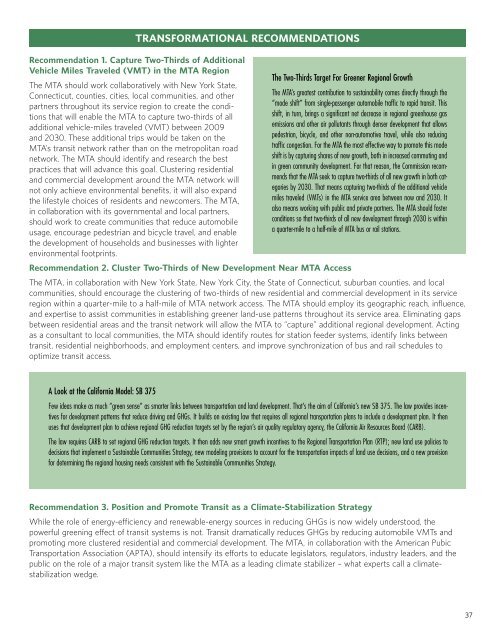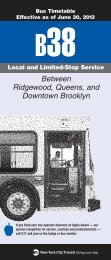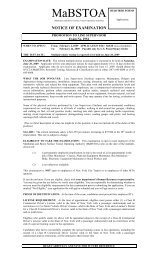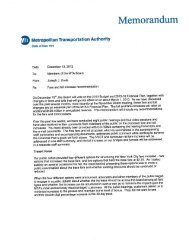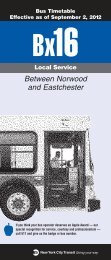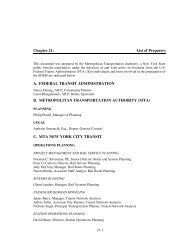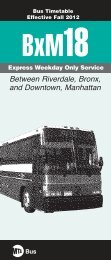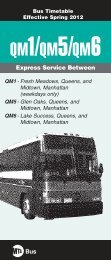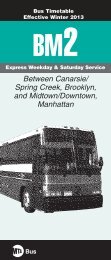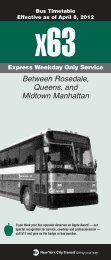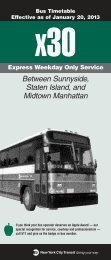Greening Mass Transit & Metro Regions: The Final Report - MTA
Greening Mass Transit & Metro Regions: The Final Report - MTA
Greening Mass Transit & Metro Regions: The Final Report - MTA
You also want an ePaper? Increase the reach of your titles
YUMPU automatically turns print PDFs into web optimized ePapers that Google loves.
TRANSFORMATIONAL RECOMMENDATIONS<br />
Recommendation 1. Capture Two-Thirds of Additional<br />
Vehicle Miles Traveled (VMT) in the <strong>MTA</strong> Region<br />
<strong>The</strong> <strong>MTA</strong> should work collaboratively with New York State,<br />
Connecticut, counties, cities, local communities, and other<br />
partners throughout its service region to create the conditions<br />
that will enable the <strong>MTA</strong> to capture two-thirds of all<br />
additional vehicle-miles traveled (VMT) between 2009<br />
and 2030. <strong>The</strong>se additional trips would be taken on the<br />
<strong>MTA</strong>’s transit network rather than on the metropolitan road<br />
network. <strong>The</strong> <strong>MTA</strong> should identify and research the best<br />
practices that will advance this goal. Clustering residential<br />
and commercial development around the <strong>MTA</strong> network will<br />
not only achieve environmental benefits, it will also expand<br />
the lifestyle choices of residents and newcomers. <strong>The</strong> <strong>MTA</strong>,<br />
in collaboration with its governmental and local partners,<br />
should work to create communities that reduce automobile<br />
usage, encourage pedestrian and bicycle travel, and enable<br />
the development of households and businesses with lighter<br />
environmental footprints.<br />
Recommendation 2. Cluster Two-Thirds of New Development Near <strong>MTA</strong> Access<br />
<strong>The</strong> <strong>MTA</strong>, in collaboration with New York State, New York City, the State of Connecticut, suburban counties, and local<br />
communities, should encourage the clustering of two-thirds of new residential and commercial development in its service<br />
region within a quarter-mile to a half-mile of <strong>MTA</strong> network access. <strong>The</strong> <strong>MTA</strong> should employ its geographic reach, influence,<br />
and expertise to assist communities in establishing greener land-use patterns throughout its service area. Eliminating gaps<br />
between residential areas and the transit network will allow the <strong>MTA</strong> to “capture” additional regional development. Acting<br />
as a consultant to local communities, the <strong>MTA</strong> should identify routes for station feeder systems, identify links between<br />
transit, residential neighborhoods, and employment centers, and improve synchronization of bus and rail schedules to<br />
optimize transit access.<br />
A Look at the California Model: SB 375<br />
<strong>The</strong> Two-Thirds Target For Greener Regional Growth<br />
<strong>The</strong> <strong>MTA</strong>’s greatest contribution to sustainability comes directly through the<br />
“mode shift” from single-passenger automobile traffic to rapid transit. This<br />
shift, in turn, brings a significant net decrease in regional greenhouse gas<br />
emissions and other air pollutants through denser development that allows<br />
pedestrian, bicycle, and other non-automotive travel, while also reducing<br />
traffic congestion. For the <strong>MTA</strong> the most effective way to promote this mode<br />
shift is by capturing shares of new growth, both in increased commuting and<br />
in green community development. For that reason, the Commission recommends<br />
that the <strong>MTA</strong> seek to capture two-thirds of all new growth in both categories<br />
by 2030. That means capturing two-thirds of the additional vehicle<br />
miles traveled (VMTs) in the <strong>MTA</strong> service area between now and 2030. It<br />
also means working with public and private partners. <strong>The</strong> <strong>MTA</strong> should foster<br />
conditions so that two-thirds of all new development through 2030 is within<br />
a quarter-mile to a half-mile of <strong>MTA</strong> bus or rail stations.<br />
Few ideas make as much “green sense” as smarter links between transportation and land development. That’s the aim of California’s new SB 375. <strong>The</strong> law provides incentives<br />
for development patterns that reduce driving and GHGs. It builds on existing law that requires all regional transportation plans to include a development plan. It then<br />
uses that development plan to achieve regional GHG reduction targets set by the region’s air quality regulatory agency, the California Air Resources Board (CARB).<br />
<strong>The</strong> law requires CARB to set regional GHG reduction targets. It then adds new smart growth incentives to the Regional Transportation Plan (RTP); new land use policies to<br />
decisions that implement a Sustainable Communities Strategy, new modeling provisions to account for the transportation impacts of land use decisions, and a new provision<br />
for determining the regional housing needs consistent with the Sustainable Communities Strategy.<br />
Recommendation 3. Position and Promote <strong>Transit</strong> as a Climate-Stabilization Strategy<br />
While the role of energy-efficiency and renewable-energy sources in reducing GHGs is now widely understood, the<br />
powerful greening effect of transit systems is not. <strong>Transit</strong> dramatically reduces GHGs by reducing automobile VMTs and<br />
promoting more clustered residential and commercial development. <strong>The</strong> <strong>MTA</strong>, in collaboration with the American Pubic<br />
Transportation Association (APTA), should intensify its efforts to educate legislators, regulators, industry leaders, and the<br />
public on the role of a major transit system like the <strong>MTA</strong> as a leading climate stabilizer – what experts call a climatestabilization<br />
wedge.<br />
37


